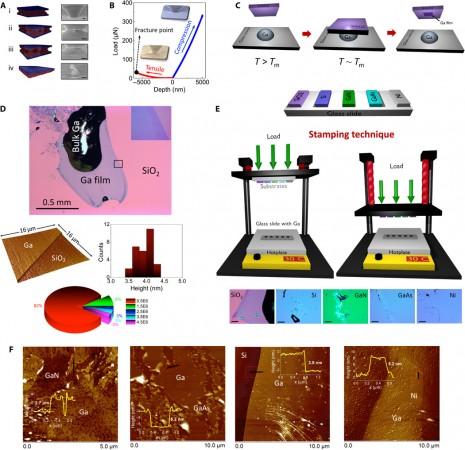
- 2D metal contacts can make our electronics thinner and flexible, which can be used in flexible electronics
- Gallenene is to gallium what graphene is to carbon
- Gallenene joins graphene in the second dimension
- Gallenene was extracted from molten gallium using the stamping technique
- Gallenene shows promise in nanoscale electronics
Graphene is probably the only 2D material that is widely known to all. Graphene's immense strength despite its single layer of carbon atoms arranged in a hexagonal frame makes it widely accepted in various mechanical and electrical fields. Soon, the limelight could be shared with a new 2D material called gallenene.
Gallenene is a 2D form of soft metal gallium, which could have great use as efficient, thin metal contacts in electronic devices. Simply put, gallenene is a thin film of conductive material and it is to gallium what graphene is to carbon.
"The current work utilizes the weak interfaces of solids and liquids to separate thin 2-D sheets of gallium," Chandra Sekhar Tiwary, an assistant professor at the Indian Institute of Technology in Bengaluru, India, told International Business Times, India, in an email statement.
Extracting gallenene from molten gallium wasn't without challenges for the researchers at the Rice University and the Indian Institute of Science. Due to gallium's melting point at just 30 degree Celsius makes it impossible to extract using vapor phase deposition methods. Gallium also oxidizes quickly and the bonds between its layers are too strong for removing a layer of gallenene the way graphene is removed from graphite with adhesive tape.

"This kind of stamping technique of solid melt exfoliation along with the understanding of amount of force required to extract 2D layers from liquid metal surface will be useful for printing scalable circuits for 2D nanoelectronics. This technique can be extended to the production of 2D layers of low melting metals such as tin, indium and lead," Vidya Kochat, Smalley Postdoctoral Fellow in Quantum Materials, Rice University, told IBTimes, India.
Researchers chose a cautious process to successfully extract gallenene by heating the metal to 29.7 degrees Celsius, just below its melting point. At this point, researchers were able to drip gallium onto a glass slide, and as soon as a drop cooled a bit a flat piece of silicon dioxide was pressed on top to lift just a few flat layers of gallenene.
"Near 2-D metals are difficult to extract, since these are mostly high-strength, nonlayered structures, so gallenene is an exception that could bridge the need for metals in the 2-D world," Tiwary said.
Researchers then explored the use-cases of gallenene and found it to bind easily to other substrates such as gallium nitride, gallium arsenide, silicon and nickel. Gallenene can also serve a great purpose as an efficient metal contact in nanoscale electronics, where 2D metal options are limited.
The research was published in the journal Science Advances.













